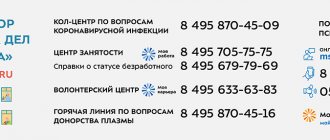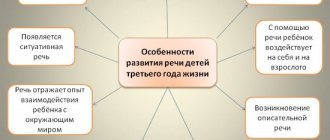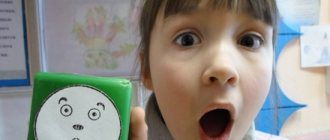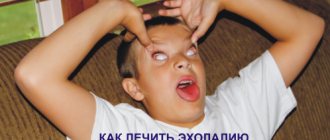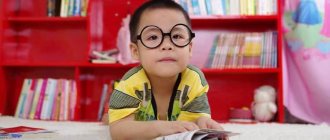General information
The localization of the pathological process leading to dysarthria in children can develop at different levels of the nervous system responsible for the formation of sounds and the logical order of the story:
- nuclei of the cranial nerves responsible for the nervous control of the tongue, lips, soft palate, etc.;
- pathways between the cortex and cerebral nuclei;
- subcortical centers;
- the cerebellum and pathways, pathways from and to it;
- cortex.
Diagnosis is carried out simultaneously by a neurologist (determines the level of topical damage to the nervous system and the nature of the pathological process) and a speech therapist (determines the degree of speech disorders in order to make a correction prognosis).
Treatment is aimed at eliminating or stabilizing the background pathology that led to speech disorders, as well as articulatory correction.
Classification
There are several options for classifying childhood dysarthria. The most common of them is associated with the localization of a pathological focus that affects the functioning of the speech center. The following forms of the disease are distinguished:
- pseudobulbar (most common);
- bulbar;
- extrapyramidal (subcortical);
- cerebellar;
- cortical.
Depending on the degree of damage and the severity of the main symptoms, the following forms of dysarthria are distinguished:
- erased: characterized by minimal pronunciation disorders;
- moderate: severe articulation defects, slurred speech, quiet voice;
- anarthria: complete absence of speech or isolated sounds.
Symptoms Parents May Notice
Erased dysarthria, as the initial stage of the disease, is manifested by minor pronunciation defects. With more serious disorders, there are omissions of sounds, breathing problems, crumpled and incomprehensible speech, or a complete inability to speak due to paralysis of the articulatory muscles. Listening to speech may be difficult. Articulatory dysarthria can occur with high muscle tone and provoke discoordination disorders and spasms. On the contrary, the features of dysarthria that occurs with hypotension are laxity of the muscles of the face, neck, tongue, the patient’s mouth is slightly open, and salivation occurs.
Symptoms of dysarthria in children
The pathogenetic mechanisms of dysarthria are multifaceted and are associated with inadequate innervation of organs involved in speech formation. These are the respiratory muscles, muscles of the lips, tongue and soft palate, larynx and vocal folds. As a result, speech becomes slurred and unclear. Concomitant signs of dysarthria in children are associated with impaired innervation of the muscles responsible for the pronunciation of sounds. Depending on the type of disorder, symptoms vary slightly:
- Muscle spasm. Tension of the lips, tongue, face and neck. The lips are tightly closed. Limitation of movements when pronouncing sounds.
- Muscle hypotension. The tongue is flaccid and lies almost motionless on the floor of the mouth. The mouth is half open, because lips do not close. There is increased salivation. Due to the immobility of the soft palate, the voice acquires a nasal tint (becomes nasal).
With dysarthria, the pronunciation of almost all sounds is impaired - both consonants and vowels.
The child softens hard consonants. When pronouncing hissing and whistling sounds, the tongue moves not forward, but to the side, and the interdental spaces are involved. Due to a complex disturbance of innervation, the characteristics of the voice also change. He becomes quiet, weak, deaf, acquires a nasal tone, etc. An imbalance in the control of the respiratory act leads to the fact that exhalation is shortened, and when speaking, breathing becomes more frequent and intermittent.
Due to slurred speech, the child cannot clearly differentiate sounds by ear. This leads to an unformed vocabulary and the inability to construct a grammatically correct sentence. Therefore, it is so important not to waste time and begin correcting speech disorders as early as possible.
Types of dysarthria and their clinical characteristics
Dysarthria is divided into types according to the location of the damage, the degree of speech impairment and the defining, most pronounced symptom.
The following types of dysarthria are distinguished:
- Bulbarnaya
- Pseudobulbar
- Cortical
- Cerebellar.
Bulbar dysarthria develops due to damage to the cranial nerves, which are located in the medulla oblongata. With this form of dysarthria, the connection between the muscles that provide articulation and the central nervous system is disrupted. As a result, the patient has difficulty performing correct movements with the tongue and lips, which are in a relaxed state. His face becomes inactive and salivation increases.
Pseudobulbar dysarthria predominantly occurs due to ischemic stroke of the brain in people over 50 years of age or at any age with traumatic brain injury. Patients have severe atrophy of the muscles of the speech apparatus, which leads to monotony of speech, difficulty chewing and swallowing, and increased salivation.
Cortical or cortical dysarthria is a speech disorder due to the following reasons:
- Damage to the frontal lobe of the brain due to trauma
- Presence of a frontal lobe tumor
- Previous diseases (encephalitis, meningitis) as a result of which neurotransmitter functions are partially lost.
With this type of dysarthria, the pronunciation of consonants and the rate of speech are disrupted, the automaticity of articulation disappears, and nasal sound appears.
Cerebellar dysarthria occurs due to damage to the cerebellum. This type of speech disorder is quite rare. She most often accompanies other dysarthria firms. Due to dysfunction of the cerebellum and its connections with other parts of the brain, patients develop disorders:
- Softness of the tongue and palate
- "Drunken Speech"
- Speech fades at the end of a phrase
- Scanning individual syllables or sounds
- Violation of accents.
Aphasiologists classify cortical dysarthria as a mild speech disorder in motor aphasia. There are efferent (premotor) and afferent (postcentral) forms of cortical dysarthria. The efferent form of cortical dysarthria occurs when there is damage to the area of the anterior central gyrus, which represents the innervation of the muscles that provide articulation. In patients, articulatory movements are impaired, but the content of speech is not impaired. This fundamentally distinguishes cortical dysarthria from aphasia. Articulatory cortical dysarthria concerns only specific speech movements. Other voluntary and involuntary movements of the lips and tongue remain intact.
The afferent form of cortical dysarthria occurs when the postcentral areas of the cerebral cortex are damaged. In adults, paretic dysarthria occurs with brain tumors. Such dysarthria in adults is compensated after removal of the tumor. Mesencephalic-diencephalic dysarthria is associated with damage to the nuclei of the cranial nerves.
Hyperkinetic dysarthria occurs in patients with cerebral palsy. It is characterized by excessive involuntary movements in the articulatory apparatus, which intensify during the speech act. In patients, hyperkinesis is clearly expressed in all parts of the speech motor apparatus and facial muscles. They are also noted in the upper extremities, becoming more frequent and intensifying when trying to speak. Less common are involuntary movements in the shoulder girdle, lower extremities and shoulder girdle.
Atactic dysarthria is observed in the atonic-astatic form of cerebral palsy. Rarely found in its pure form. More often it is a concomitant syndrome against the background of spastic paresis or hyperkinesis. The leading syndrome in ataxic dysarthria is ataxia. It manifests itself in hypermetric, asynergic disturbances of articulatory movements and in the scantiness of the rhythm of speech. Optical disturbances occur with an erased form of dysarthria.
Paroxysmal dysarthria is observed in patients suffering from multiple sclerosis and other diseases of the nervous system. Patients experience isolated attacks that usually last less than 1 minute, but can recur up to several times a day. Sometimes they are triggered by anxiety or hyperventilation. Dysarthria can reach such a severe degree that a person’s speech becomes completely unintelligible. People with dysarthria may experience associated symptoms such as numbness, double vision, or weakness. Mixed dysarthria develops in children after trauma.
Causes of dysarthria
Among the most common causes of dysarthria in children are:
- toxicosis;
- antenatal hypoxia;
- immune conflict according to the ABO system and the Rh factor;
- chronic pathologies in a mother carrying a child;
- complicated course of labor;
- birth injuries;
- birth before 37 weeks;
- asphyxia.
All these factors can lead to organic brain damage, incl.
centers responsible for speech development. At the same time, cerebral palsy often develops, and its severity correlates with the severity of speech disorders. In addition, dysarthria can develop in early childhood in an initially healthy child. In this case, the reasons lie in severe neuroinfections and intoxications, for example, carbon monoxide, alcohol poisoning, etc., as well as tumors and brain injuries.
Diagnosis of dysarthria in children
Dysarthria in children is a disorder that is often accompanied by other neurological symptoms and disorders, so the child must be examined not only by speech therapists, but also by neurologists.
The neurologist conducts an objective examination, assesses the severity of reflexes and prescribes additional diagnostic methods. As a rule, neurosonography is an ultrasound examination of the brain that allows identifying focal lesions. Rheoencephalography and encephalography may also be performed.
Speech therapy testing is aimed at assessing speech and non-speech disorders. Non-speech parameters:
- development of facial and speech muscles;
- range of motion in the temporomandibular joint;
- breathing pattern, etc.
Speech assessment parameters:
- pronunciation;
- synchronicity of the work of organs involved in the formation of speech;
- correct pronunciation of sounds, construction of sentences, etc.
Based on a comprehensive examination, the severity of dysarthria is determined. There are 4 degrees of speech impairment:
- First degree (erased form) - speech disorders are invisible to others and are detected only during a speech therapy examination.
- Second degree – speech is understandable, but there are defects in the pronunciation of sounds.
- Third degree - speech becomes slurred, only people from close circle understand it.
- The fourth degree (anarthria) – speech is completely slurred, even people who are constantly with the child cannot understand it.
The main differences between dysarthria and other speech therapy diagnoses
Dysarthria differs from dyslalia by severe neurological symptoms. In addition, sound pronunciation is grossly impaired; not only the sounds of early ontogenesis are affected, but also vowels. The voice is deaf, weak, fine and general motor skills are impaired, mental processes are reduced: memory, attention, thinking. The child experiences frequent mood swings and hyperactivity. With alalia it is differentiated according to the principle of the absence of primary disturbances in speech production and language operations, which is expressed in the peculiarities of the development of the lexical and grammatical structure of speech.
The main directions of correctional work for dysarthria
When treating dysarthria, an integrated approach is used, and the work of a speech therapist is required. Speech therapy is carried out along with medicinal and non-medicinal means of influence: physiotherapy, medications to relieve muscle spasms, exercise therapy, reflexology, massage. Psychological and pedagogical work is also important, which includes:
|
Treatment of dysarthria
Treatment of dysarthria in children depends on the severity of symptoms, the cause of the disease and the location of the pathological focus.
Regardless of the form of the disorder, therapy includes two basic areas: therapeutic (neurological) and speech therapy. A neurologist provides therapy for the underlying disease that has led to speech impairment. For this purpose, vascular drugs, nootropics, vitamins and others can be prescribed. If there is a brain tumor compressing the speech center, removal is indicated (at this stage a neurosurgeon is involved).
Speech therapy methods for working with a child suffering from dysarthria include:
- stabilization of the tone of the muscles responsible for articulation: speech therapy massage, taping, speech gymnastics;
- exercises aimed at developing motor skills: rhythm, finger gymnastics, etc.;
- breathing control and voice control training;
- production of sounds;
- development of vocabulary, etc.
It takes a lot of time to correct violations. It is important to remember that both doctors and speech therapists, as well as parents, should treat dysarthria in a child. Regular training and exercises at home also contribute to the speedy restoration of speech functions.
In achieving the desired results, the start of therapy as early as possible, the diligence of the parents and the patient himself are of great importance. SM-Doctor specialists build a program of work with the child in such a way that motivation to achieve the goal does not disappear at any stage, but only increases. This and the high professionalism of speech therapists, neurologists and other doctors involved make it possible to achieve high results and restore speech intelligibility.
Tests according to Mastyukova
Along with examining the mobility of the articulatory apparatus, Mastyukova’s functional tests for dysarthria are used in isolated tests. Test No. 1 is performed as follows. The patient is asked to open his mouth, stick his tongue forward and hold it motionless in the midline. At the same time, he must follow with his eyes an object moving in lateral directions (pencil, finger). Using this test, the ability to hold the tongue in the midline and the presence of synkinesis (additional movements that occur involuntarily during basic functional movements) are assessed.
During the second test, the patient is asked to move his tongue up and down. In this case, the researcher’s hands lie on the patient’s neck. The presence or absence of tension in the cervical muscles and synkinesis during tongue movement is noted.
The doctor checks the isolated pronunciation of vowels and consonants. Then the ability to pronounce sounds in syllables, words, and phrases is tested. Tasks are used that consist of repeated repetition of one sound. In this case, conditions are created that reduce articulatory switching from one sound to another. This allows the neurologist to detect difficulties in the innervation of the articulatory act, especially in cases of “erased” dysarthria.
When studying the prosodic side of speech, the speech therapist pays attention to the following characteristics:
- Pace (normal, slow, fast);
- Rhythm (normal, arrhythmic);
- Preservation of pauses in the flow of speech (chanting, dividing words into syllables);
- Voice strength (loud, loud, unmodulated);
- Voice pitch (low, high);
- Voice timbre (normal, nasal, hoarse, hoarse);
- Speech intelligibility (clear, blurry).
The doctor checks the state of vocabulary and grammatical structure of speech. Difficult cases of dysarthria are discussed at a meeting of the Expert Council with the participation of leading experts in the field of neurology, psychology, and speech therapy. A conclusion is drawn that indicates the form of dysarthria, the nature of the violation of sound pronunciation and the prosodic side of speech, the lexical and grammatical side of speech. Along with the clinical diagnosis made by the neurologist, a speech therapy conclusion is made.
Prognosis and prevention
The result of treatment depends on the type of disorder and its degree. Regularity of exercise is important. Only constant training and thorough implementation of the doctor’s recommendations will allow you to completely or partially cope with the problem. If we are talking about severe disability, in which dysarthria arose against the background of other pathologies, the likelihood of successful correction is significantly reduced.
Prevention of the disease includes general measures: reducing the risk of injury, a healthy lifestyle during pregnancy, etc.
As soon as you begin to notice the first signs of dysarthria in a preschooler, do not delay your visit to specialists. Only a comprehensive specialized examination will identify or eliminate the problem. At SM-Doctor you will be met by competent doctors and speech therapists who will help you establish an objective diagnosis and correct the identified disorders. Sign up for a consultation with professionals at a convenient time! We find an approach to every child, even the most difficult.
